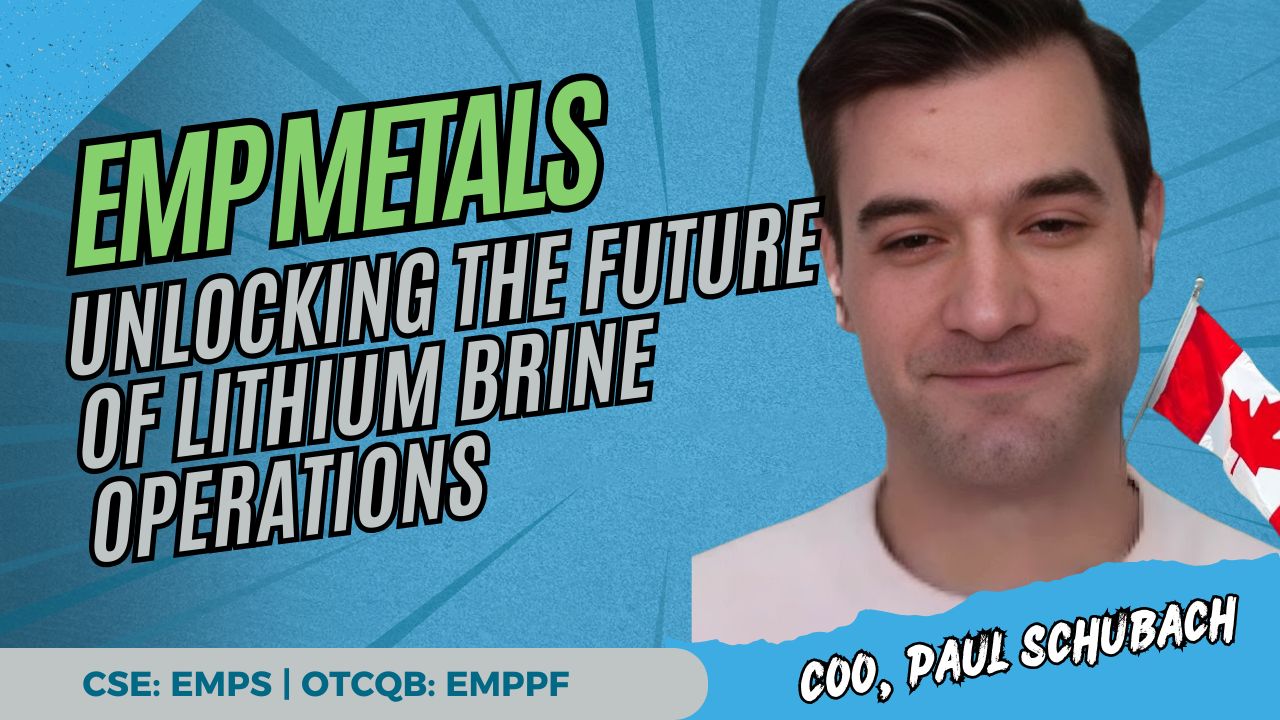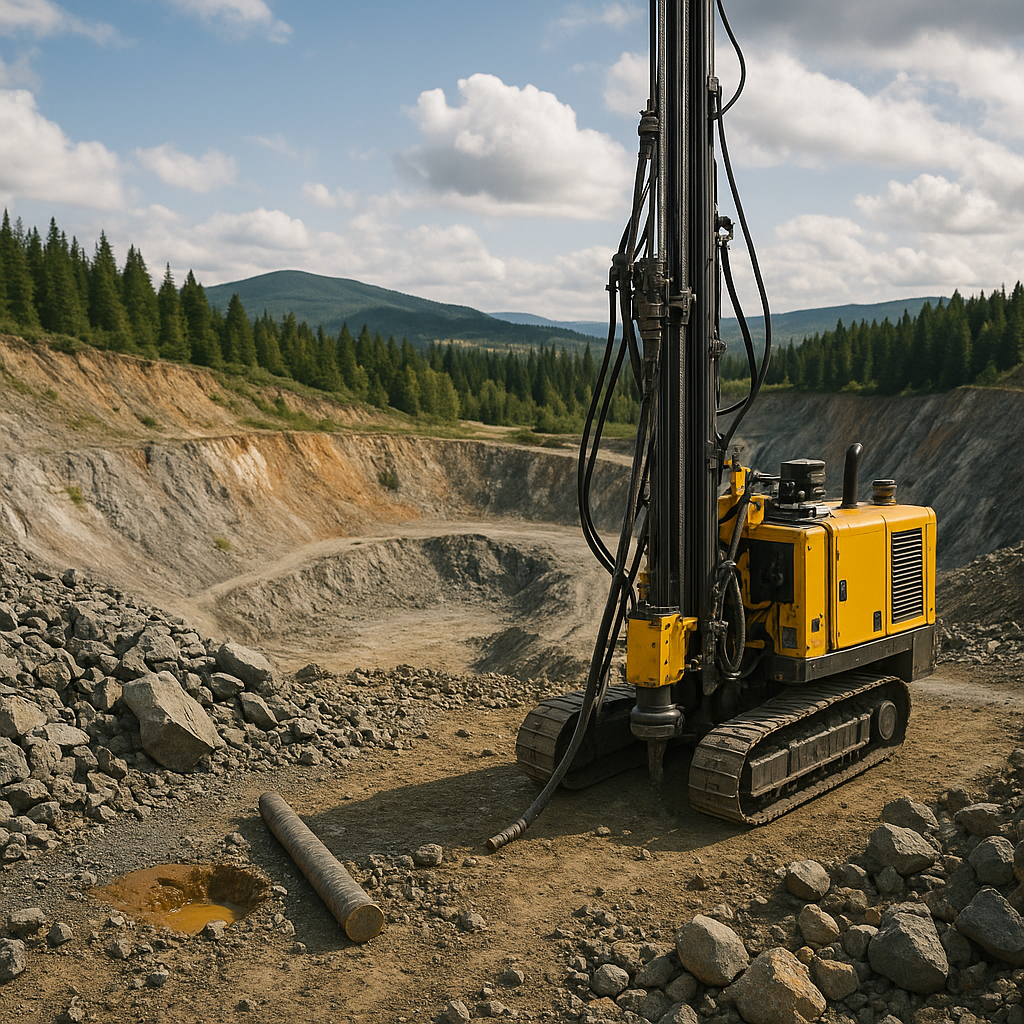In today’s interview, EMP Metals (CSE: EMPS) (OTCQB: EMPPF) shares key insights into their innovative approach to lithium brine extraction and the critical role their latest project developments play in shaping the future of clean energy storage. As global lithium demand accelerates, EMP Metals is focusing on high-grade resource development, sustainable exploration methods, and the adoption of cutting-edge technology to maintain a competitive edge. This conversation dives deep into the company’s strategy, project milestones, and how they are positioning themselves for strategic partnerships with major battery manufacturers and EV companies.
Whether you’re an investor, industry professional, or simply curious about lithium’s role in the energy revolution, this interview offers valuable perspectives on the opportunities and challenges facing EMP Metals in the evolving market.
Watch the interview below or continue on to read the full interview transcript.
1. The global demand for lithium in renewable energy and EVs?
Yeah, so our goal and vision here at EMP is to responsibly develop a project that can deliver lithium chemicals into an industry that’s advancing the way that we both store and consume clean energy. I think lithium brines, lithium brine operations in general, have many benefits in comparison to traditional ways that lithium is mined or extracted. And so advancements in the implementation of a DLE process in a lithium brine process will allow mining operations to lower greenhouse gases, lower water usage, lower chemicals, and also reduce the time it takes to bring lithium chemicals into the market.
2. The horizontal flow testing program reported an average lithium concentration of 241 mg/L with strong flow rates. What does this mean in terms of the project’s commercial potential and global competitiveness?
Yes, our flow testing program that was just completed—I would like to note this is the first extended flow testing program for lithium in southeast Saskatchewan. By extended, I mean we flow-tested this well for over 60 days. The concentration achieved with this flow test has confirmed our subsurface strategy: that we can target individual high-grade zones of the reservoir and produce them at high flow rates.
We do have plans for some infrastructure upgrades to increase these flow rates even further, targeting upwards of 2,000 cubic meters per day per well for commercial-scale operations. In general, lithium concentration has a large impact on project economics. Higher-grade zones allow us to produce more tonnage while moving the same volume of fluid, which helps drive both CapEx and OpEx down.
3. The Mansur 3 test well results established a new project area. How significant is this for EMP Metals’ overall portfolio and growth strategy?
So, the Mansur 3 test well does a few things for us. First, it confirms a contiguous, high-grade resource that extends from our Viewfield property, where we’ve tested upwards of 259 milligrams per liter. Moving west into the southern Mansur land base, another test showed over 200 milligrams per liter. This brings more confidence to the resource across our land base.
Second, the high concentration at Mansur helps drive overall project economics and opens up the Southern Mansur block as a potential expansion area. Third, it confirms that expansion and scale potential within our Saskatchewan land base is possible.
4. What are the next steps for EMP Metals following the positive results from both the horizontal flow testing program and the Mansur 3 test well?
Our next steps include continuing fieldwork and completing a detailed engineering (or FEED) study for the stage one facility at the Viewfield property. This study will give us more confidence in project economics and help refine both CapEx and OpEx.
We’re also acquiring additional freehold and crown mineral titles to expand our existing acreage and increase resource tonnage. Additional field testing is planned for water source and injection well testing. We’re also advancing discussions on a demonstration facility at Viewfield to further de-risk subsurface and DLE technology before larger commercial operations.
5. With global lithium demand expected to triple in the next decade, how does EMP Metals plan to scale operations to meet this growing demand?
We’re approaching this project with a small modular hub-and-spoke facility design. The brine in Saskatchewan has a good balance of high concentration and low impurities, which helps with scalability. We’re targeting an initial facility that can produce around 3,000 tons per year. By starting with a smaller facility, we can lower CapEx and learn through its development while allowing for rapid expansion.
We also plan to implement innovation as we scale by building additional modular facilities throughout our land base to meet the growing demand for lithium chemicals.
6. ESG considerations are increasingly important to investors. How is EMP Metals prioritizing sustainability in its exploration and production methods?
Lithium brine projects have many ESG advantages over traditional hard rock mining. Our estimates indicate lower greenhouse gas emissions, minimal surface disruption, and the elimination of surface tailings or brine ponds. By using DLE, 99% of impurities can remain in the brine and be immediately re-injected into disposal zones.
Our project is located within extensive farmland in southeast Saskatchewan, and the infrastructure (such as surface refining facilities and well pads) can coexist with agricultural operations. This allows landowners to continue growing crops without major disruption.
7. Can you explain the significance of flow rates and lithium concentration levels for investors who may not be familiar with these metrics?
Facilities are typically sized and developed around maximum flow rates. Higher lithium concentrations mean we need less flow volume and smaller infrastructure (pipelines, vessels, and pumps) to achieve the same output tonnage. By optimizing for high concentration, we can effectively lower both CapEx and OpEx while maintaining high production rates.
8. What role does technology and innovation play in EMP Metals’ ability to achieve these positive results and remain competitive in the industry?
Technology and innovation are at the forefront of DLE today. Over the past few years, significant advancements have been made. Larger companies like Rio Tinto, ExxonMobil, and Equinor are entering the space and pursuing DLE projects, which indicates strong growth.
At the same time, small, nimble companies are developing both resources and technology. These developments will be pivotal in the success and implementation of DLE projects.
9. How does EMP Metals position itself to attract strategic partnerships with major battery manufacturers and EV companies? For investors considering lithium as part of their portfolio, what differentiates EMP Metals from other players in the market?
EMP Metals stands out for several reasons. First, we have a high-quality asset in Saskatchewan with high concentration and low contamination (no H₂S or oil). This provides a major cost advantage by eliminating expensive extraction processes.
Second, we operate in a stable, resource-friendly jurisdiction with competitive incentives. Saskatchewan has a strong history of supporting resource industries like potash, uranium, and oil and gas, which gives us access to local talent and existing infrastructure.
Lastly, we have a small, nimble team with extensive experience in operations, capital markets, and oil and gas. This allows us to advance and de-risk our project methodically and cost-effectively.
10. What are some major catalysts investors should watch for this year that will build shareholder value?
We have several fieldwork initiatives lined up to further de-risk the project. One major focus is the development of a small-scale demonstration plant to answer key questions about subsurface conditions and DLE performance.
If successful, this will bring confidence in our ability to supply and dispose of brine at commercial volumes. Success at this stage will also build momentum as we move towards full commercial production in the coming years.
With a focus on high-quality assets, environmental sustainability, and a stable development environment in Saskatchewan, EMP Metals is making significant strides in advancing its lithium projects. The company’s methodical approach to de-risking and scalability, combined with strategic partnerships and infrastructure advantages, positions them as a key player in the North American lithium industry.
As EMP Metals continues to pursue key milestones like demonstration plants and further resource expansion, the future looks promising. Stay tuned for more updates on their journey to become a leader in clean energy materials, and remember to follow for the latest news on investing trends and industry insights.
Disclaimer: This article is for informational and entertainment purposes only and does not constitute financial advice. Please conduct your own research or consult with a financial advisor before making investment decisions.





